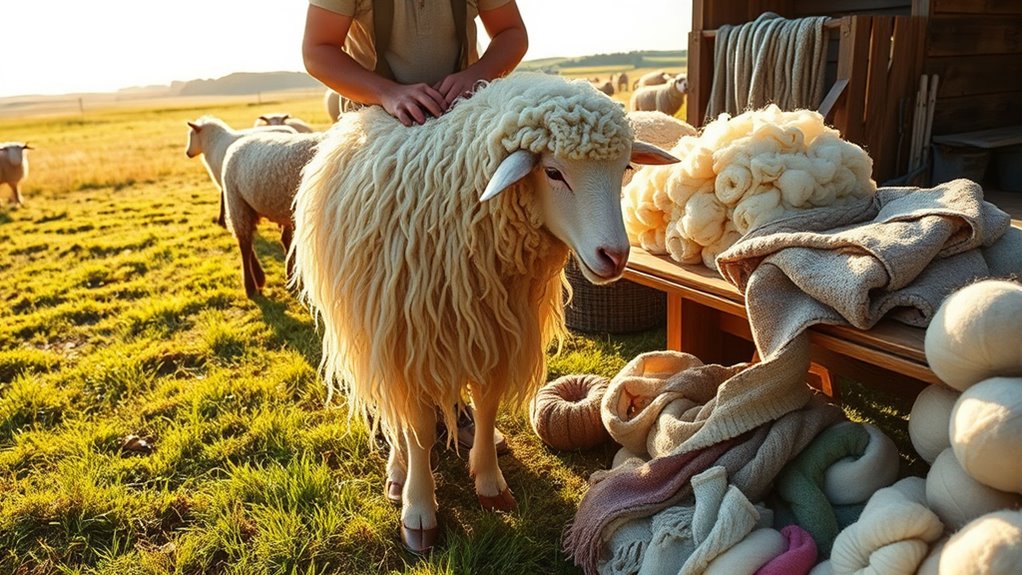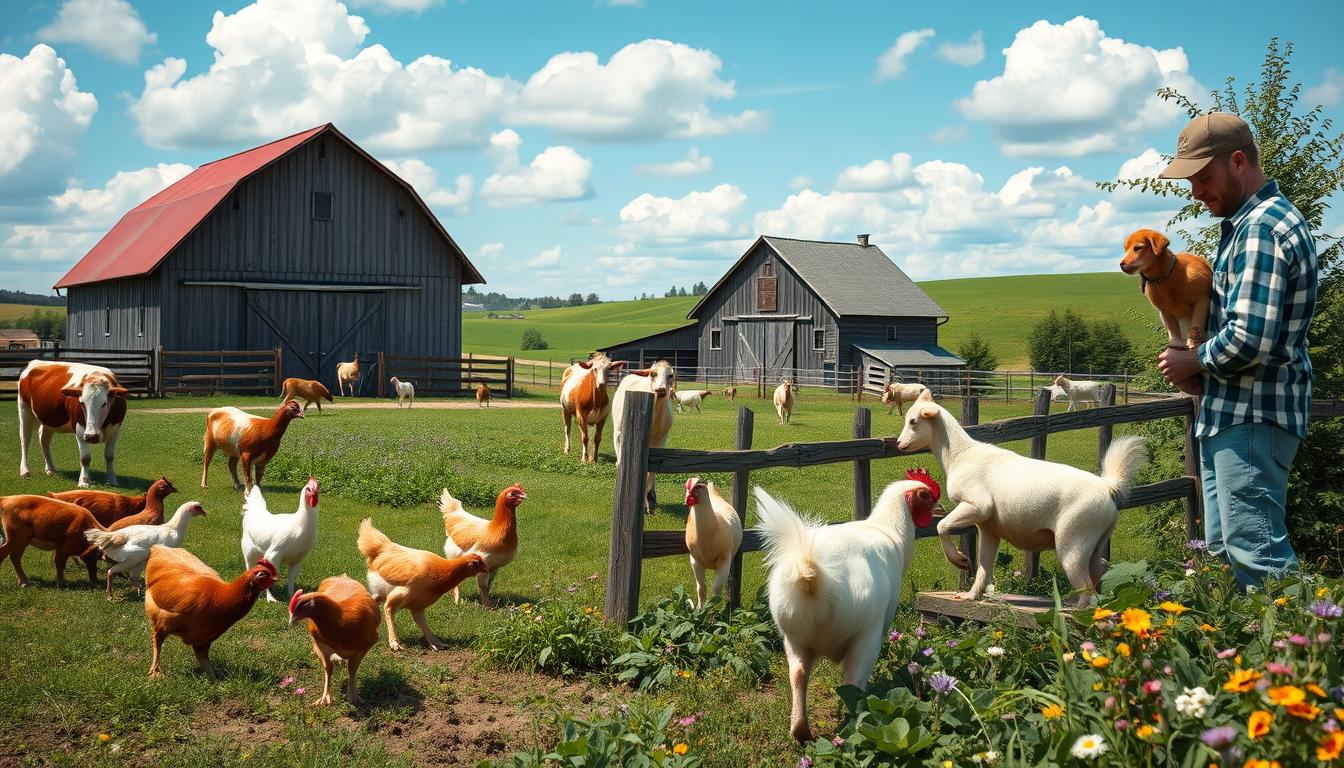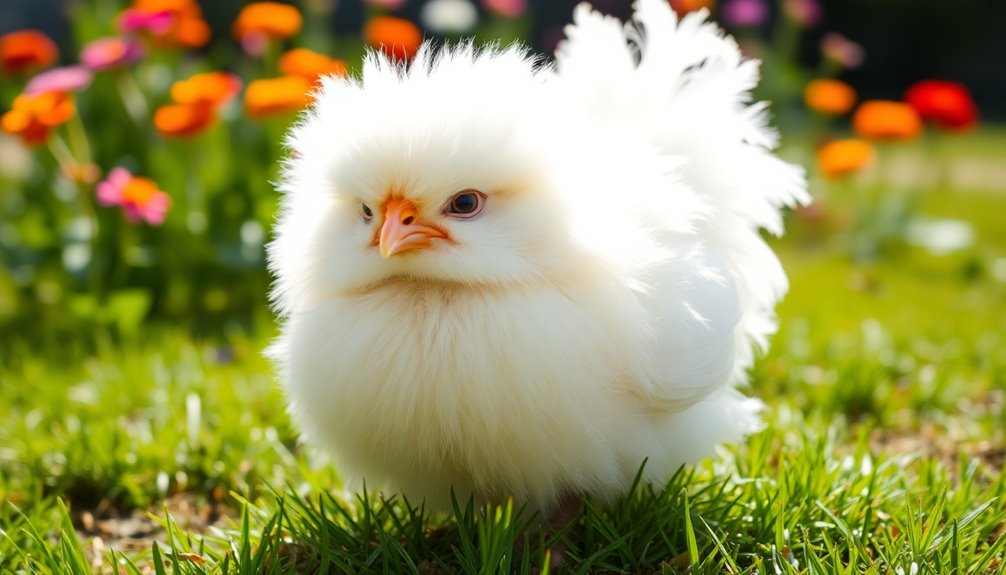To manage sheep wool effectively, start by preparing your sheep for shearing: make certain they're clean and fasting for at least eight hours. On shearing day, create a calm environment and use gentle handling techniques. Master proper shearing strokes while focusing on ergonomics. After shearing, clean and store wool carefully to maintain quality. Wool has numerous applications from clothing to eco-friendly materials. Discover more about maximizing wool's potential and innovative techniques to elevate your wool management practices.
Key Takeaways
- Proper shearing techniques enhance wool quality and promote sheep health, reducing the risk of overheating and skin diseases.
- Preparing sheep by fasting and ensuring clean, dry wool is essential for a smooth shearing process.
- Post-shearing practices like skirting fleece and proper storage maintain wool quality and market value.
- Wool is versatile, used in clothing, insulation, home furnishings, and eco-friendly packaging materials.
- Sustainable wool production supports local economies, reduces synthetic fiber reliance, and promotes environmental health through responsible farming practices.
Preparing Your Sheep for Shearing
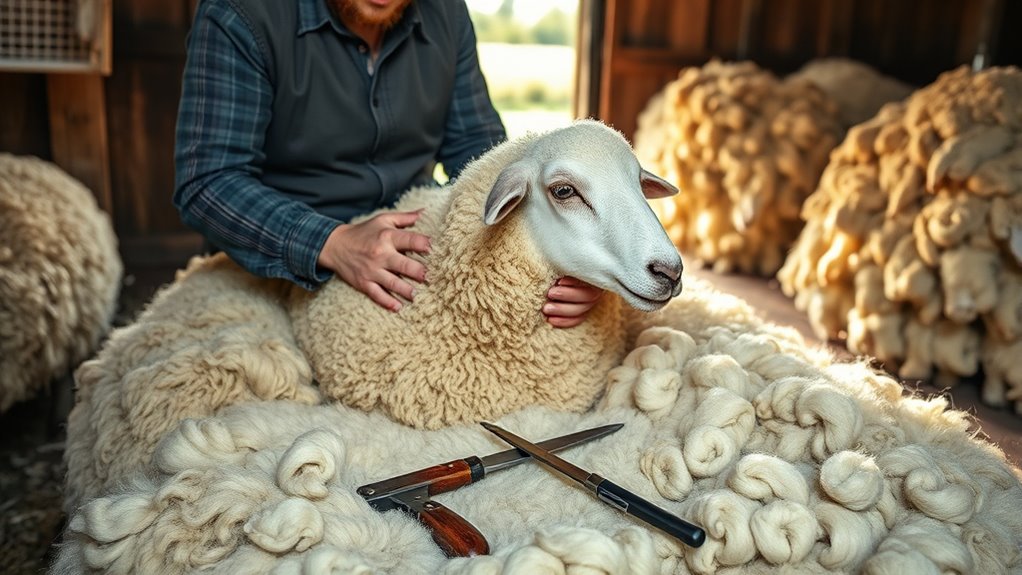
Preparing your sheep for shearing is essential to guarantee a smooth process and maintain the quality of the fleece. Start by ensuring your sheep are fasted for at least 8 hours before shearing. This helps prevent discomfort and health issues during the process.
Next, make sure the wool is clean and dry, as wet fleece is harder to shear and can diminish wool quality. Choose a sheltered, well-ventilated area for shearing to minimize heat stress on your sheep. Avoid penning them on concrete floors, which can contaminate the fleece and negatively impact its market value.
Finally, monitor your sheep for any signs of health issues, prioritizing their wellbeing throughout this preparation stage.
Shearing Day Tips
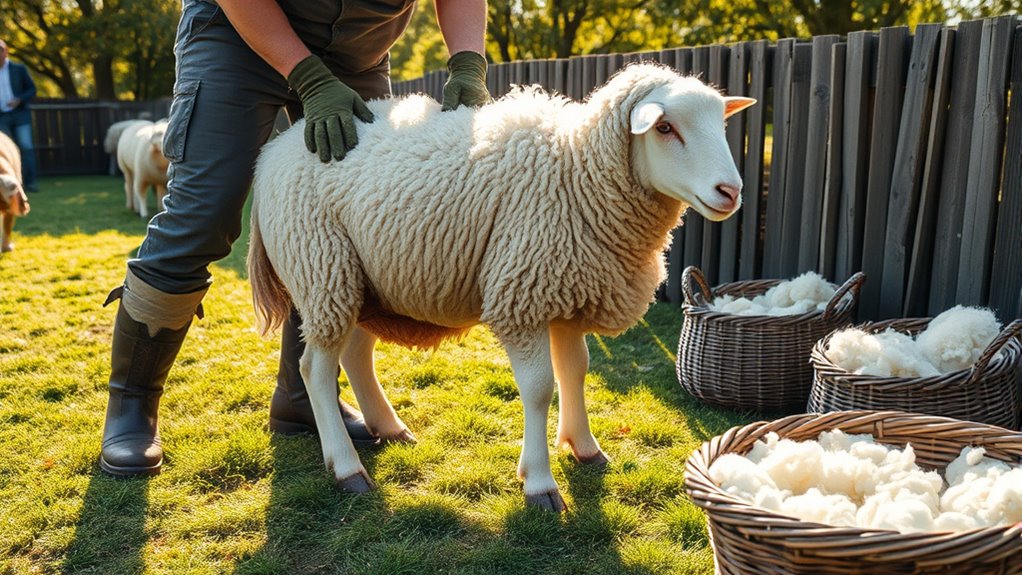
On shearing day, handling your sheep gently is essential to building trust and minimizing stress.
Keeping the environment quiet and free from distractions will help maintain calmness, benefiting both you and the sheep.
Gentle Handling Techniques
While shearing can be a stressful time for sheep, gentle handling techniques can make all the difference in guaranteeing a calm experience.
As a sheep shearer, you should prioritize building trust with the sheep. Use a rope to lead particularly wary ones, allowing for a more controlled approach before the shearing process begins. This gentle handling not only eases the sheep's anxiety but also helps you work more efficiently.
Additionally, minimizing distractions is essential; keep other animals away from the shearing area to maintain focus. Regularly check for any health issues before shearing to verify the sheep's comfort.
Quiet Environment Essentials
Creating a quiet environment on shearing day is essential for reducing stress in sheep, which in turn leads to a smoother process.
To achieve this, consider these tips:
- Isolate the shearing area from other animals and loud noises.
- Keep the space well-ventilated to reduce heat stress and enhance calmness.
- Encourage handlers to speak softly and maintain a calm demeanor.
- Use non-threatening movements to reassure the sheep.
- Monitor the atmosphere to identify and minimize distractions.
Mastering the Shearing Technique
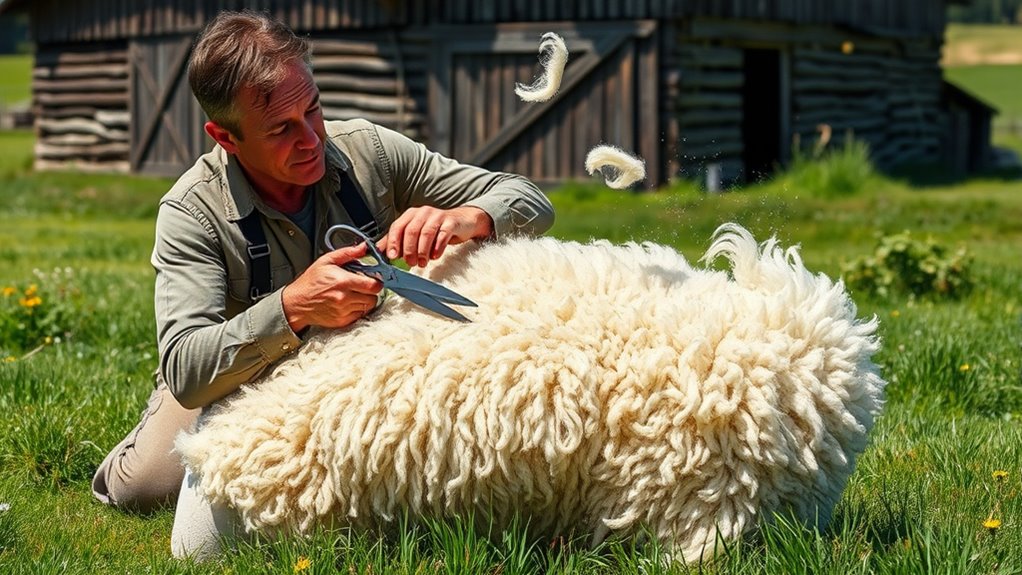
When it comes to mastering shearing techniques, you'll want to focus on essential strokes and proper equipment maintenance.
Understanding ergonomics is key, as a comfortable setup not only boosts your efficiency but also keeps the sheep calm.
With regular practice and attention to these details, you'll refine your skills and enhance your flock management.
Shearing Techniques Overview
Mastering shearing techniques is essential for ensuring both the efficiency of the process and the comfort of the sheep.
To successfully shear your sheep and produce high-quality wool, consider these key points:
- Learn from experienced shearers to refine your strokes.
- Use confident, steady movements to reduce sheep stress.
- Pay attention to ergonomics for better positioning.
- Regular practice helps build muscle memory and rhythm.
- Select high-quality shears tailored to your flock's needs.
Equipment and Tool Maintenance
After honing your shearing techniques, it's crucial to focus on the maintenance of your equipment and tools. Proper care guarantees peak performance and safety for both you and the sheep. Regularly inspect and clean your shearing equipment, and always keep your sheep shears' blades sharp. Dull blades can cause uneven cuts and increase the risk of injuries.
Apply clipper oil before and after each session to maintain smooth operation. Familiarize yourself with your specific maintenance guidelines to enhance longevity. Store your equipment in a dry, clean environment to prevent rust.
| Task | Frequency |
|---|---|
| Inspect and clean | After each use |
| Sharpen blades | As needed |
| Apply clipper oil | Before & after |
Ergonomics for Efficient Shearing
Effective shearing relies heavily on proper ergonomics, which can greatly enhance both your comfort and efficiency. By adopting ergonomic practices, you can substantially improve your shearing experience.
Here are some key tips:
- Position the sheep securely on its side for easier access to the shearing area.
- Adjust the shearing surface to maintain a comfortable working height.
- Use electric shears with a steady grip to guarantee consistent cutting.
- Take regular breaks to alleviate muscle tension and prevent strain injuries.
- Alternate your shearing position and tools to reduce wrist strain.
Implementing these strategies not only helps you work more efficiently but also minimizes discomfort and injuries, making your shearing sessions more productive.
Additional Tips for a Flawless Shear
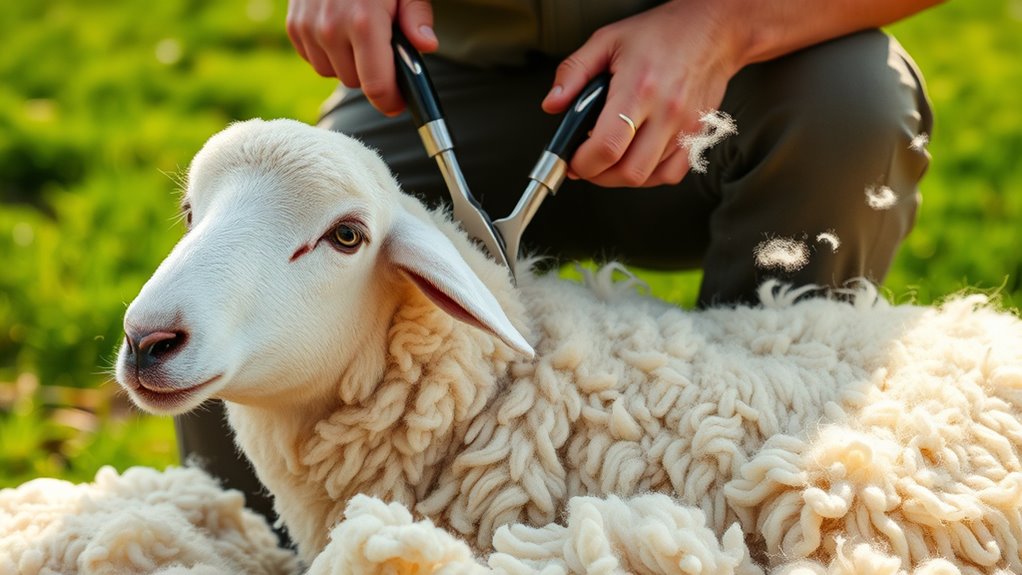
To achieve a flawless shear, it's essential to prepare both your sheep and your equipment carefully. Start by ensuring your sheep are clean, dry, and fasted for at least 8 hours prior to shearing. This facilitates a smoother process and improves the quality of the wool.
Invest in high-quality shears that suit your flock's size and wool type, and always have extra sharp blades and clipper oil on hand. Sanitize your shearing equipment before and after use to maintain health standards, especially with sheep that may have infections.
Create a quiet, distraction-free environment to minimize stress during shearing. Finally, prepare clean surfaces or bags for immediate wool collection to preserve the fleece's quality and readiness for market.
Post-Shearing Practices
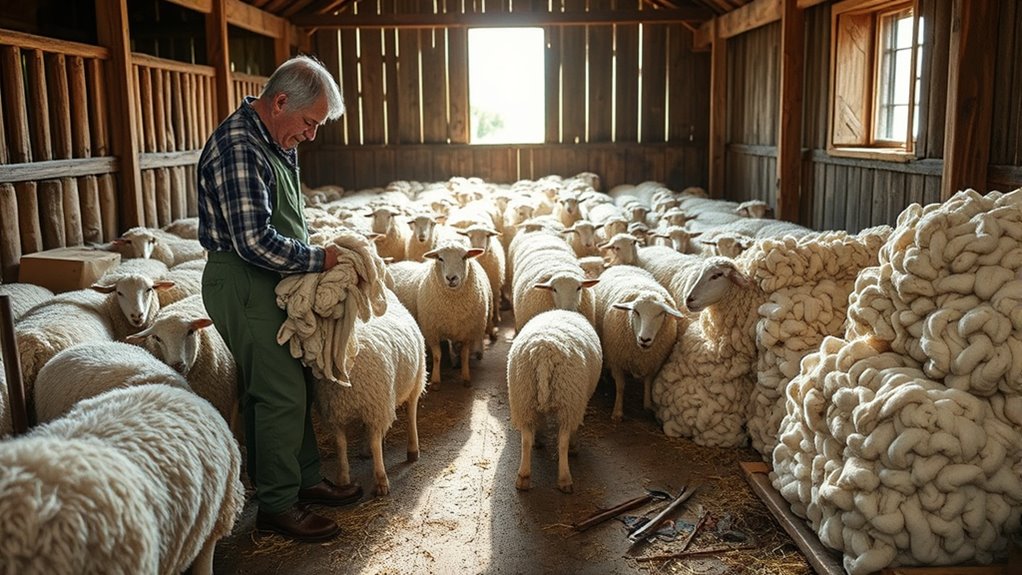
Once you've sheared your sheep, skirting the fleece becomes essential to maintaining its quality.
You'll want to remove any belly wool, tags, and soiled areas to guarantee the fleece is exceptional.
Following this, keep up with your post-shearing practices for the best results:
- Clean the shearing area thoroughly after each sheep to prevent contamination.
- Store the sorted wool in clean, dry conditions to preserve its quality.
- Package your wool properly in cardboard boxes or clear plastic bags to avoid damage.
- Label bags with different grades of wool to enhance market value.
- Organize your storage for easy access and selling.
Wool Quality Improvement and Innovations
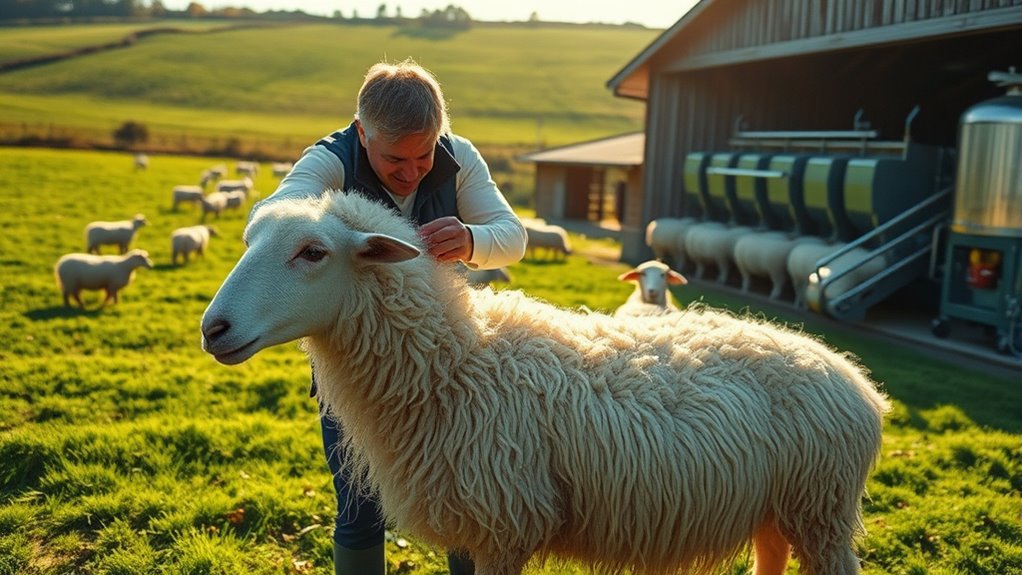
After skirting the fleece, focusing on wool quality improvement and innovations can greatly impact your wool's market potential.
To maintain high value, shear colored sheep last to prevent contamination of white wool with black fibers. Also, avoid materials like polypropylene during handling and storage, as they can undermine quality.
Innovations such as Bioclip technology are revolutionizing shearing, allowing fleece removal without traditional methods, enhancing efficiency and animal welfare.
Research into breeding sheep with bare britch areas aims to simplify shearing while reducing fly strike risk, benefiting both wool quality and sheep health.
Additionally, advancements in robotic shearing technology promise to increase precision, consistency, and lower labor costs, ensuring your wool remains competitive in the market.
Exploring the Uses of Sheep Wool
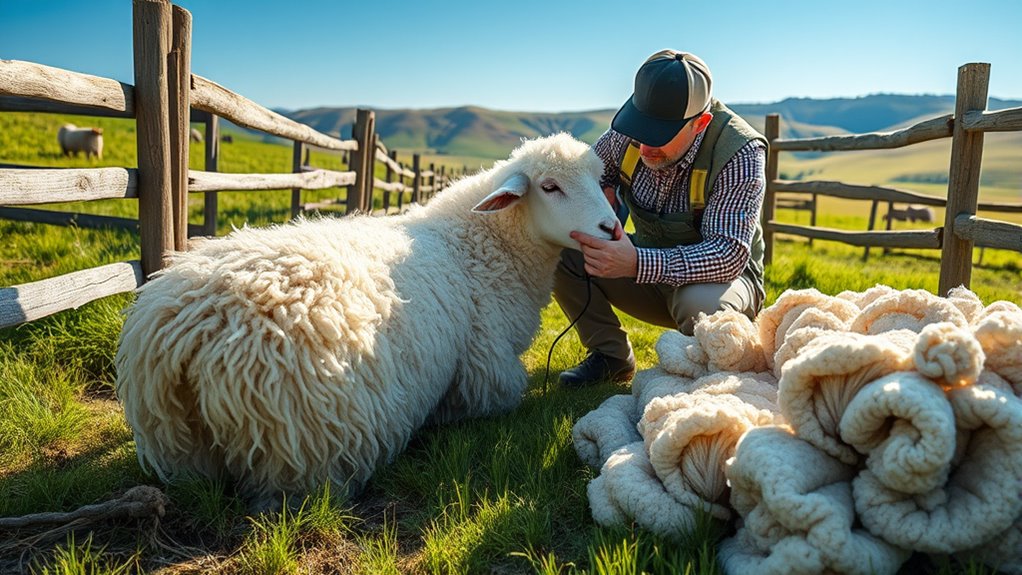
While many people associate sheep wool primarily with clothing, its uses extend far beyond the textile industry. You'll find that wool, especially from sheared sheep, serves a variety of purposes. Here are some exciting applications:
- Insulation for buildings
- Upholstery for furniture
- Natural mulch in gardening
- Biodegradable packaging materials
- Soundproofing in construction
Wool's natural warmth and moisture-wicking properties make it perfect for creating comfortable garments and durable home goods.
Plus, it's a renewable and biodegradable resource, aligning with the growing demand for sustainable materials.
As you explore these diverse applications, you'll see just how valuable shearing can be, transforming raw wool into essential products for both everyday life and eco-friendly practices.
Frequently Asked Questions
What to Do With Sheep Wool After Shearing?
After shearing, you should first skirt the fleece to remove any belly wool and contaminants, ensuring quality.
Next, wash the wool in hot water with detergent to eliminate dirt and grease, rinsing thoroughly.
Once clean, pick out any remaining vegetable matter before carding the fibers to align them.
This preparation makes your wool ready for spinning into yarn or crafting, so store it in a clean, dry place until you're ready to use it.
What Do People Do With Sheep Wool?
When it comes to sheep wool, the possibilities are endless! You can transform it into cozy clothing, luxurious blankets, and durable carpets.
People also craft yarns for knitting and weaving, using different grades for various applications. Beyond textiles, you'll find wool in eco-friendly insulation and biodegradable packaging.
This versatile material not only keeps you warm but also contributes to sustainable practices, proving its worth in many industries. It's truly a wool wonder!
What Is Shearing in Sheep Management?
Shearing in sheep management is the process of carefully removing the fleece from sheep, which helps maintain their health and comfort.
You'll want to schedule this at least once a year, typically in spring, to prevent overheating and skin issues.
Regular shearing not only keeps your sheep hygienic but also allows you to spot any health problems early.
Plus, it maximizes wool yield, ensuring you get the best quality for your needs.
Is Sheep Wool Worth Anything?
You might think sheep wool's just a byproduct, but it's actually quite valuable!
High-quality wool can fetch prices between $1.00 and $7.00 per pound, depending on its grade. If you're managing sheep, understanding market demands can help you profit considerably.
The global wool market's worth billions, and specific breeds like Merino can yield even higher returns.
Conclusion
In managing your sheep's wool, remember that a good shear can feel as satisfying as finding that perfect pair of vintage jeans. By preparing properly, mastering your technique, and caring for your sheep post-shearing, you can enhance wool quality and guarantee it's ready for various uses. Embrace the innovations in wool management, and you'll not only keep your flock healthy but also enjoy the rewards of your hard work—because great wool is always in style!

